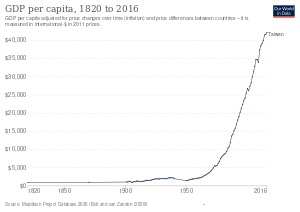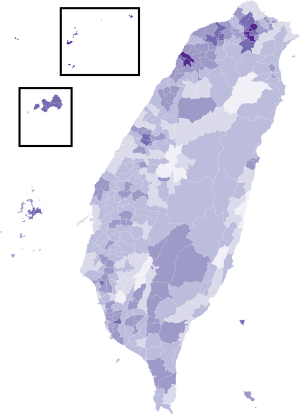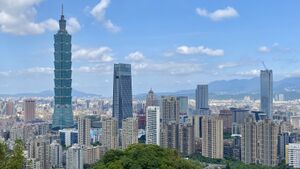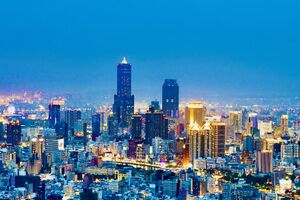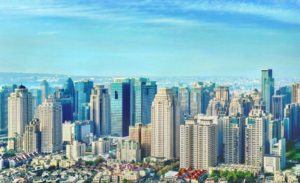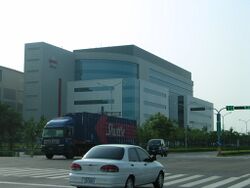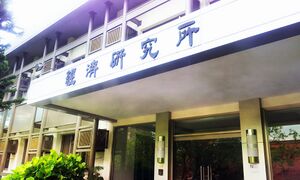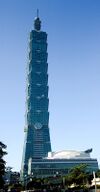اقتصاد تايوان
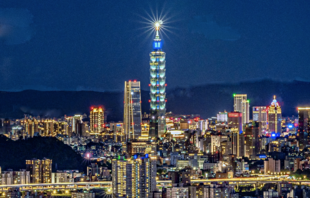 Taipei, the capital city and financial centre of Taiwan | |
| العملة | دولار تايوان الجديد (NTD) |
|---|---|
| سنة التقويم | |
منظمات التجارة | WTO, APEC and ICC (as Separate Customs Territory of Taiwan, Penghu, Kinmen and Matsu) |
| احصائيات | |
| السكان | |
| ن.م.إ | |
| ترتيب ن.م.إ | |
نمو ن.م.إ |
|
ن.م.إ للفرد | |
ن.م.إ للفرد |
|
| 1.98% (2021 est.)[4] | |
السكان تحت خط الفقر | 1.5% (2012 est.)[5] |
| 33.6 medium (2014)[5] | |
القوة العاملة | 11.49 million (2020 est.)[5] |
القوة العاملة حسب المهنة |
|
| البطالة | ▼ 3.68% (2020)[4] |
الصناعات الرئيسية |
|
| الخارجي | |
| الصادرات | ▲ $345.28 billion (2020)[7] |
السلع التصديرية | semiconductors, petrochemicals, automobile/auto parts, ships, wireless communication equipment, flat display displays, steel, electronics, plastics, computers |
شركاء التصدير الرئيسيين |
|
| الواردات | ▲ $286.49 billion (2020)[7] |
السلعة المستوردة | oil/petroleum, semiconductors, natural gas, coal, steel, computers, wireless communication equipment, automobiles, fine chemicals, textiles |
شركاء الاستيراد الرئيسيين |
|
رصيد ا.أ.م | |
| ▲ $98.6 billion (2021 est.)[4] | |
إجمالي الديون الخارجية | ▲ $181.9 billion (31 December 2017 est.)[5] |
| المالية العامة | |
| ▼ 35.5% of GDP (2020)[5][note 1] | |
| العوائد | 91.62 billion (2017 est.)[5] |
| النفقات | 92.03 billion (2017 est.)[5] |
احتياطيات العملات الأجنبية | ▲ $541.48 billion (Jan 2021)[14] |
اقتصاد تايوان هو highly developed free-market economy. It is the 8th largest in Asia and 18th-largest in the world by purchasing power parity, allowing Taiwan to be included in the advanced economies group[15] by the International Monetary Fund. It is gauged in the high-income economies group by the World Bank.[16] Taiwan is the most technologically advanced computer microchip maker in the world.[17][18][19][20]
. . . . . . . . . . . . . . . . . . . . . . . . . . . . . . . . . . . . . . . . . . . . . . . . . . . . . . . . . . . . . . . . . . . . . . . . . . . . . . . . . . . . . . . . . . . . . . . . . . . . . . . . . . . . . . . . . . . . . . . . . . . . . . . . . . . . . . . . . . . . . . . . . . . . . . . . . . . . . . . . . . . . . . . .
التاريخ
Taiwan has transformed itself from a recipient of U.S. aid in the 1950s and early 1960s to an aid donor and major foreign investor, with investments primarily centered in Asia. Private Taiwanese investment in mainland China is estimated to total in excess of US$150 billion,[21][مطلوب مصدر أفضل] and official tallies cite Taiwan as having invested a comparable amount in Southeast Asia.
Taiwan has historically benefited from the flight of many well-educated, wealthy Chinese to settle on the island[لم يمكن التحقق]: during early Qing Dynasty, the preceding Ming dynasty supporters survived for a brief period of time in exile in Taiwan, and in 1949, as the Chinese Communist Party gained control of mainland China, two million Kuomintang (KMT) supporters fled to the island.[22][23][24]
The first step towards industrialization was land reforms, a crucial step in modernizing the economy, as it created a class of landowners with capital they can invest in future economic endeavors. US aid was also important to stabilize post-war Taiwan, and it constituted more than 30 percent of domestic investment from 1951 to 1962. These factors, together with government planning and universal education, brought huge advancement in industry and agriculture, and living standards. The economy shifted from an agriculture-based economy (32% of GDP in 1952) to an industry-oriented economy (47% of GDP in 1986).[25][مطلوب مصدر أفضل] Between 1952 and 1961, the economy grew by an average of 9.21% each year.[25][مطلوب مصدر أفضل]
Once again, the transformation of Taiwan's economy cannot be understood without reference to the larger geopolitical framework. Although aid was cut back in the 1970s, it was crucial in the formative years, spurring industrialization, and security and economic links between Taiwan and the United States were maintained. Uncertainty about the US commitment accelerated the country's shift from subsidized import-substitution in the 1950s to export-led growth. Development of foreign trade and exports helped absorb excess labor from the decreased importance of agriculture in the economy.[25][مطلوب مصدر أفضل] Taiwan moved from cheap, labor-intensive manufactures, such as textiles and toys, into an expansion of heavy industry and infrastructure in the 1970s, and then to advanced electronics in the subsequent decade. By the 1980s, the economy was becoming increasingly open and the government moved towards privatization of government enterprises.[25][مطلوب مصدر أفضل] Technological development led to the establishment of the Hsinchu Science Park in 1981. Investments in mainland China spurred cross-strait trade, decreasing Taiwan's dependence on the United States market.[25][مطلوب مصدر أفضل] From 1981 to 1995, the economy grew at an annual rate of 7.52%, and the service sector became the largest sector at 51.67%, surpassing the industrial sector and becoming a major source of the economy's growth.
International Trade is officially assisted by Taiwan External Trade Development Council.[26] Because of the financial policy[27] by the Central Bank of the Republic of China (Taiwan) and its entrepreneurial strengths,[28] Taiwan suffered little from the financial crisis of 1997-1999 compared to other economies in the region.
البيانات
The following table shows the main economic indicators in 1980–2019 (with IMF staff estimates in 2020–2025).[29] Inflation under 2% is in green.
| Year | GDP
(in Bil. US$PPP) |
GDP per capita
(in US$ PPP) |
GDP
(in Bil. US$nominal) |
GDP per capita
(in US$ nominal) |
GDP growth
(real) |
Inflation rate
(in Percent) |
Unemployment
(in Percent) |
Government debt
(in % of GDP) |
|---|---|---|---|---|---|---|---|---|
| 1980 | 61.6 | 3,446.2 | 42.3 | 2,366.8 | ▲8.0% | ▲19.0% | 1.2% | n/a |
| 1981 | ▲72.2 | ▲3,967.2 | ▲49.0 | ▲2,691.5 | ▲7.1% | ▲16.3% | ▲1.4% | n/a |
| 1982 | ▲80.3 | ▲4,338.3 | ▲49.5 | ▲4.8% | ▲3.0% | ▲2.1% | n/a | |
| 1983 | ▲91.0 | ▲4,843.1 | ▲54.1 | ▲2,881.7 | ▲9.0% | ▲1.4% | ▲2.7% | n/a |
| 1984 | ▲103.8 | ▲5,441.4 | ▲61.1 | ▲3,202.6 | ▲10.0% | ▲0.0% | ▼2.5% | n/a |
| 1985 | ▲112.2 | ▲5,808.8 | ▲63.6 | ▲3,293.9 | ▲4.8% | ▲-0.2% | ▲2.9% | n/a |
| 1986 | ▲127.6 | ▲6,541.8 | ▲78.2 | ▲4,008.1 | ▲11.5% | ▲0.7% | ▼2.7% | n/a |
| 1987 | ▲147.5 | ▲7,475.6 | ▲105.0 | ▲5,325.2 | ▲12.8% | ▲0.5% | ▼2.0% | n/a |
| 1988 | ▲164.9 | ▲8,264.1 | ▲126.5 | ▲6,338.1 | ▲8.0% | ▲1.3% | ▼1.7% | n/a |
| 1989 | ▲186.3 | ▲9,243.6 | ▲152.7 | ▲7,575.9 | ▲8.7% | ▲4.4% | ▼1.6% | n/a |
| 1990 | ▲204.0 | ▲9,999.4 | ▲166.6 | ▲8,167.2 | ▲5.5% | ▲4.1% | ▲1.7% | n/a |
| 1991 | ▲228.6 | ▲11,091.9 | ▲187.1 | ▲9,081.9 | ▲8.4% | ▲4.3% | ▼1.5% | n/a |
| 1992 | ▲253.2 | ▲12,171.2 | ▲222.9 | ▲10,715.5 | ▲8.3% | ▲4.3% | n/a | |
| 1993 | ▲276.9 | ▲13,186.4 | ▲236.3 | ▲11,256.7 | ▲6.8% | ▲3.0% | n/a | |
| 1994 | ▲304.0 | ▲14,353.8 | ▲256.2 | ▲12,099.7 | ▲7.5% | ▲3.8% | ▲1.6% | n/a |
| 1995 | ▲330.5 | ▲15,475.9 | ▲279.1 | ▲13,066.1 | ▲6.5% | ▲3.9% | ▲1.8% | n/a |
| 1996 | ▲357.4 | ▲16,602.1 | ▲292.5 | ▲13,588.3 | ▲6.2% | ▲2.9% | ▲2.6% | n/a |
| 1997 | ▲385.5 | ▲17,731.3 | ▲303.3 | ▲13,948.7 | ▲6.1% | ▲0.9% | ▲2.7% | 25.0% |
| 1998 | ▲406.3 | ▲18,526.5 | ▲4.2% | ▲1.5% | ▼23.7% | |||
| 1999 | ▲439.7 | ▲19,903.7 | ▲303.8 | ▲13,752.7 | ▲6.7% | ▲0.4% | ▲2.9% | ▲23.7% |
| 2000 | ▲478.1 | ▲21,460.9 | ▲330.7 | ▲14,844.2 | ▲6.3% | ▲1.2% | ▲3.0% | ▲26.2% |
| 2001 | ▲482.0 | ▲21,512.3 | ▲-0.2% | ▲4.6% | ▲30.1% | |||
| 2002 | ▲516.3 | ▲22,927.3 | ▲307.4 | ▲13,651.4 | ▲5.5% | ▲-0.2% | ▲5.2% | ▼29.8% |
| 2003 | ▲548.8 | ▲24,277.2 | ▲317.4 | ▲14,040.6 | ▲4.2% | ▲-0.2% | ▼5.0% | ▲32.2% |
| 2004 | ▲602.7 | ▲26,562.5 | ▲346.9 | ▲15,290.3 | ▲7.0% | ▲1.6% | ▼4.4% | ▲33.4% |
| 2005 | ▲655.0 | ▲28,767.3 | ▲374.1 | ▲16,427.5 | ▲5.4% | ▲1.9% | ▼4.1% | ▲34.1% |
| 2006 | ▲714.2 | ▲31,220.7 | ▲386.5 | ▲16,892.9 | ▲5.8% | ▲0.9% | ▼3.9% | ▼33.3% |
| 2007 | ▲783.8 | ▲34,138.8 | ▲406.9 | ▲17,723.7 | ▲6.9% | ▲1.8% | ▼32.2% | |
| 2008 | ▲805.2 | ▲34,951.8 | ▲415.9 | ▲18,053.6 | ▲0.8% | ▲3.0% | ▲4.1% | ▲33.4% |
| 2009 | ▲-0.4% | ▲5.9% | ▲36.7% | |||||
| 2010 | ▲889.5 | ▲38,404.3 | ▲444.3 | ▲19,181.4 | ▲10.2% | ▲1.1% | ▼5.2% | ▲36.9% |
| 2011 | ▲941.4 | ▲40,532.6 | ▲484.0 | ▲20,838.6 | ▲3.7% | ▲1.4% | ▼4.4% | ▲38.3% |
| 2012 | ▲973.2 | ▲41,741.3 | ▲495.6 | ▲21,256.4 | ▲2.2% | ▲1.6% | ▼4.2% | ▲39.2% |
| 2013 | ▲1,015.2 | ▲43,435.5 | ▲512.9 | ▲21,945.5 | ▲2.5% | ▲1.0% | ▼38.9% | |
| 2014 | ▲1,066.1 | ▲45,494.3 | ▲535.3 | ▲22,844.3 | ▲4.7% | ▲1.3% | ▼4.0% | ▼37.5% |
| 2015 | ▲1,102.0 | ▲46,911.0 | ▲1.5% | ▲-0.6% | ▼3.8% | ▼35.9% | ||
| 2016 | ▲1,112.8 | ▲47,272.3 | ▲543.1 | ▲23,070.7 | ▲2.2% | ▲1.0% | ▲3.9% | ▼35.4% |
| 2017 | ▲1,143.2 | ▲48,500.8 | ▲590.7 | ▲25,061.6 | ▲3.3% | ▲1.1% | ▼3.8% | ▼34.5% |
| 2018 | ▲1,203.2 | ▲51,005.0 | ▲609.2 | ▲25,825.6 | ▲2.8% | ▲1.5% | ▼3.7% | ▼33.9% |
| 2019 | ▲1,261.0 | ▲53,424.4 | ▲612.2 | ▲25,935.9 | ▲3.0% | ▲0.5% | ▲3.7% | ▼32.7% |
| 2020 | ▲1,316.0 | ▲55,855.8 | ▲668.2 | ▲28,358.3 | ▲3.1% | ▲-0.2% | ▲3.9% | |
| 2021 | ▲1,443.4 | ▲61,371.0 | ▲785.6 | ▲33,401.7 | ▲5.9% | ▲1.6% | ▼3.8% | ▼27.2% |
| 2022 | ▲1,532.7 | ▲65,283.9 | ▲850.5 | ▲36,227.1 | ▲3.3% | ▲1.5% | ▼3.6% | ▼22.8% |
| 2023 | ▲1,610.2 | ▲68,706.7 | ▲899.9 | ▲38,397.0 | ▲2.6% | ▲1.4% | ▼18.2% | |
| 2024 | ▲1,683.8 | ▲71,976.1 | ▲953.3 | ▲40,749.6 | ▲2.2% | ▲1.4% | ▼13.6% | |
| 2025 | ▲1,756.2 | ▲75,201.8 | ▲999.5 | ▲42,801.8 | ▲2.1% | ▲1.4% | ▼8.9% | |
| 2026 | ▲1,829.8 | ▲78,495.1 | ▲1,048.5 | ▲44,978.6 | ▲2.1% | ▲1.4% | ▼4.2% |
. . . . . . . . . . . . . . . . . . . . . . . . . . . . . . . . . . . . . . . . . . . . . . . . . . . . . . . . . . . . . . . . . . . . . . . . . . . . . . . . . . . . . . . . . . . . . . . . . . . . . . . . . . . . . . . . . . . . . . . . . . . . . . . . . . . . . . . . . . . . . . . . . . . . . . . . . . . . . . . . . . . . . . . .
الاسمي
| السنة | النمو الاقتصادي (%) | -- | ن.م.ا. للفرد (USD) | النمو (%) |
|---|---|---|---|---|
| 1951 | - | -- | 154 | - |
| 1952 | 12.00 | -- | 208 | 35.06 |
| 1953 | 9.49 | -- | 178 | -14.42 |
| 1954 | 9.64 | -- | 188 | 5.62 |
| 1955 | 7.72 | -- | 216 | 14.89 |
| 1956 | 6.17 | -- | 151 | -30.09 |
| 1957 | 7.81 | -- | 170 | 12.58 |
| 1958 | 7.68 | -- | 185 | 8.82 |
| 1959 | 8.81 | -- | 140 | -24.32 |
| 1960 | 7.20 | -- | 163 | 16.43 |
| 1961 | 7.05 | -- | 161 | -1.23 |
| 1962 | 8.93 | -- | 172 | 6.83 |
| 1963 | 10.74 | -- | 189 | 9.88 |
| 1964 | 12.63 | -- | 214 | 13.23 |
| 1965 | 11.89 | -- | 229 | 7.01 |
| 1966 | 9.63 | -- | 249 | 8.73 |
| 1967 | 11.15 | -- | 281 | 12.85 |
| 1968 | 9.71 | -- | 319 | 13.52 |
| 1969 | 9.59 | -- | 357 | 11.91 |
| 1970 | 11.51 | -- | 397 | 11.20 |
| 1971 | 13.43 | -- | 451 | 13.60 |
| 1972 | 13.87 | -- | 530 | 17.52 |
| 1973 | 12.83 | -- | 706 | 33.21 |
| 1974 | 2.67 | -- | 934 | 32.29 |
| 1975 | 6.19 | -- | 985 | 5.46 |
| 1976 | 14.28 | -- | 1,158 | 17.56 |
| 1977 | 11.41 | -- | 1,330 | 14.85 |
| 1978 | 13.56 | -- | 1,606 | 20.75 |
| 1979 | 8.83 | -- | 1,950 | 21.42 |
| 1980 | 8.04 | -- | 2,389 | 22.51 |
| 1981 | 7.10 | -- | 2,720 | 13.86 |
| 1982 | 4.81 | -- | 2,699 | -0.77 |
| 1983 | 9.02 | -- | 2,903 | 7.56 |
| 1984 | 10.05 | -- | 3,224 | 11.06 |
| 1985 | 4.81 | -- | 3,314 | 2.79 |
| 1986 | 11.51 | -- | 4,036 | 21.79 |
| 1987 | 12.75 | -- | 5,350 | 32.56 |
| 1988 | 8.02 | -- | 6,370 | 19.07 |
| 1989 | 8.72 | -- | 7,613 | 19.51 |
| 1990 | 5.54 | -- | 8,205 | 7.78 |
| 1991 | 8.37 | -- | 9,125 | 11.21 |
| 1992 | 8.31 | -- | 10,768 | 18.01 |
| 1993 | 6.81 | -- | 11,242 | 4.40 |
| 1994 | 7.50 | -- | 12,150 | 8.08 |
| 1995 | 6.50 | -- | 13,119 | 7.98 |
| 1996 | 6.18 | -- | 13,641 | 3.98 |
| 1997 | 6.05 | -- | 14,020 | 2.78 |
| 1998 | 4.20 | -- | 12,820 | -8.56 |
| 1999 | 6.73 | -- | 13,804 | 7.68 |
| 2000 | 6.31 | -- | 14,908 | 8.00 |
| 2001 | -1.40 | -- | 13,397 | -10.14 |
| 2002 | 5.48 | -- | 13,686 | 2.16 |
| 2003 | 4.22 | -- | 14,066 | 2.78 |
| 2004 | 6.95 | -- | 15,317 | 8.89 |
| 2005 | 5.38 | -- | 16,456 | 7.44 |
| 2006 | 5.77 | -- | 16,934 | 2.90 |
| 2007 | 6.85 | -- | 17,757 | 4.86 |
| 2008 | 0.80 | -- | 18,081 | 1.82 |
| 2009 | -1.61 | -- | 16,933 | -6.35 |
| 2010 | 10.25 | -- | 19,197 | 13.37 |
| 2011 | 3.67 | -- | 20,866 | 8.69 |
| 2012 | 2.22 | -- | 21,295 | 2.06 |
| 2013 | 2.48 | -- | 21,973 | 3.18 |
| 2014 | 4.72 | -- | 22,874 | 4.10 |
| 2015 | 1.47 | -- | 22,780 | -0.41 |
| 2016 | 2.17 | -- | 23,091 | 1.37 |
| 2017 | 3.31 | -- | 25,080 | 8.61 |
| 2018 | 2.75 | -- | 25,792 | 2.84 |
| 2019 | 2.71 | -- | 25,909 | 0.45 |
| 2020 | 3.11 | -- | 28,383 | 9.5 |
الاقتصاد حسب المنطقة
| Rank | cities | NTD | US$ | PPP |
|---|---|---|---|---|
| 1 | Taipei | 990,292 | 30,699 | 65,539 |
| 2 | Hsinchu City | 853,089 | 26,446 | 56,459 |
| - | Taipei-Keelung metropolitan area | 830,788 | 25,754 | 54,982 |
| - | Taipei-Keelung-Taoyuan metropolitan area | 807,860 | 25,044 | 53,465 |
| 3 | New Taipei | 733,776 | 22,747 | 48,562 |
| 4 | Taoyuan | 731,518 | 22,677 | 48,413 |
| - | Taiwan | 727,098 | 22,540 | 48,120 |
| 5 | Taichung | 724,905 | 22,472 | 47,975 |
| 6 | Hsinchu County | 724,840 | 22,470 | 47,971 |
| 7 | Penghu County | 709,066 | 21,981 | 46,927 |
| 8 | Chiayi City | 709,033 | 21,980 | 46,925 |
| 9 | Keelung | 706,808 | 21,911 | 46,777 |
| 10 | Yilan County | 700,034 | 21,701 | 46,329 |
| 11 | Hualien County | 693,292 | 21,492 | 45,883 |
| 12 | Kaohsiung | 684,260 | 21,212 | 45,285 |
| 13 | Kinmen County | 668,582 | 20,726 | 44,248 |
| 14 | Miaoli County | 657,292 | 20,376 | 43,500 |
| 15 | Tainan | 643,743 | 19,956 | 42,604 |
| 16 | Taitung County | 623,485 | 19,328 | 41,263 |
| 17 | Changhua County | 618,969 | 19,188 | 40,964 |
| 18 | Yunlin County | 607,776 | 18,841 | 40,223 |
| 19 | Pingtung County | 592,066 | 18,354 | 39,184 |
| 20 | Nantou County | 569,453 | 17,653 | 37,687 |
| 21 | Chiayi County | 562,743 | 17,445 | 37,243 |
المستقبل الاقتصادي
As of 2018, the three highest paid sectors in Taiwan include telecommunication, financial services and utilities.[33] The economy of Taiwan ranked the highest in Asia in the 2015 Global Entrepreneurship Index (GEI).[34] With the technocracy-centered economic planning[35] until 1987, real growth in GDP has averaged about 8% during the past three decades. Exports have grown since World War II, with inflation and unemployment staying low and foreign reserves being the world's fourth largest. Directorate-General of Budget, Accounting and Statistics[36] and Ministry of Economic Affairs[37] release major economic indicators of the economy of Taiwan.
Taiwan now faces many of the same economic issues as other developed economies. With the prospect of continued relocation of labor-intensive industries to economies with cheaper workforces, such as in mainland China, the Philippines and Vietnam, Taiwan's future development will have to rely on further transformation to a high technology and service-oriented economy.[38] In recent years, Taiwan has successfully diversified its trade markets, cutting its share of exports to the United States from 49% in 1984 to 20% in 2002. Taiwan's dependence on the United States should continue to decrease as its exports to Southeast Asia and mainland China grow and its efforts to develop European markets produce results.[39] Taiwan's accession to the WTO and its desire to become an Asia-Pacific "regional operations center" are spurring further economic liberalization. The economy of Taiwan is facing economic marginalisation in the world economy [40] de-internationalization and lower salaries. This results in human resource talents seeking career opportunities elsewhere. Businesses in Taiwan suffer most from being the size of small and medium enterprises, which impedes attempts of economic transformation of Taiwan by the Taiwanese government.[41]
The Indirect tax system of the economy of Taiwan comprises Gross Business Receipts Tax (GBRT) (Gross receipts tax) and Value-added tax.[42] The economy of Taiwan is ranked 15th overall in the Global Top 20 Top Destination Cities by International Overnight Visitors (2014) by the MasterCard 2014 Global Destination Cities Index.[43]
الأزمة المالية العالمية
Taiwan recovered quickly from the global financial crisis of 2007–2010, and its economy has been growing steadily since. Its economy faced a downturn in 2009 due to a heavy reliance on exports which in turn made it vulnerable to world markets.[39] Unemployment reached levels not seen since 2003, and the economy fell 8.36% in the fourth quarter of 2008.[38] In response, the government launched a US$5.6 billion economic stimulus package (3% of its GDP), provided financial incentives for businesses, and introduced tax breaks.[38] The stimulus package focused on infrastructure development, small and medium-sized businesses, tax breaks for new investments, and low-income households.[38] Boosting shipments to new overseas markets, such as Russia, Brazil, and the Middle East was also a main goal of the stimulus.[38] The economy has since slowly recovered; by November 2010, Taiwan's unemployment rate had fallen to a two-year low of 4.73%,[44] and continued dropping to a 40-month low of 4.18% by the end of 2011.[45] The average salary has also been rising steadily for each month in 2010, up 1.92% from the same period in 2009.[46] Industrial output for November 2010 reached another high, up 19.37% from a year earlier, indicating strong exports and a growing local economy.[47] Private consumption is also increasing, with retail sales up 6.4% compared to 2009.[48] After 10.5% economic growth in 2010, the World Bank expected growth to continue and reach 5% for 2011.[49]
According to the National Development Council, Taiwan's economy declined in May 2019 due to the ongoing China-United States trade war.[50]
التجارة الخارجية
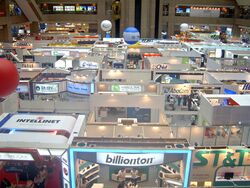
Foreign trade has been the engine of Taiwan's rapid growth during the past 40 years. Taiwan's economy remains export-oriented, thus it depends on an open world trade regime and remains vulnerable to downturns in the world economy. The total value of trade increased over fivefold in the 1960s, nearly tenfold in the 1970s, and doubled again in the 1980s.[53] The 1990s saw a more modest, slightly less than twofold, growth. Export composition changed from predominantly agricultural commodities to industrial goods (now 98%). The electronics sector is Taiwan's most important industrial export sector and is the largest recipient of United States investment.
Taiwan is a member of numerous trade agreements, with China, Japan, USA, the European Union, and Hong Kong as top 5 trade partners in 2010.[54][55] Taiwan has the world's lowest fertility rate and high housing prices. Labor shortages, falling domestic demand, and declining tax revenues, are concerns as Taiwan's population decline is faster than other advanced economies.[56][57]
As an island economy with lack of natural resources and comparatively lower domestic aggregate demand, Taiwan's highly educated human resources[58] would contribute greatly to Value added Innovation management[59][60][61][62] for expanding[63] Taiwan's international trade.
Taiwan, as an independent economy, became a member of the World Trade Organization (WTO) as Separate Customs Territory of Taiwan, Penghu, Kinmen and Matsu (often shortened to "Chinese Taipei"-both names resulting from PRC interference on the WTO) in January 2002. In a 2011 report by Business Environment Risk Intelligence (BERI), Taiwan ranked third-best globally for its investment environment.[64]
Taiwan is the world's largest supplier of contract computer chip manufacturing (foundry services) and is a leading LCD panel manufacturer,[65] DRAM computer memory, networking equipment, and consumer electronics designer and manufacturer.[39] Major hardware companies include Acer, Asus, HTC, Foxconn, TSMC and Pegatron. Textiles are another major industrial export sector, though of declining importance due to labor shortages, increasing overhead costs, land prices, and environmental protection.[66]
Imports are dominated by raw materials and capital goods, which account for more than 90% of the total. Taiwan imports most of its energy needs. The United States is Taiwan's third largest trading partner, taking 11.4% of Taiwanese exports and supplying 10.0% of its imports.[54][55] Mainland China has recently become Taiwan's largest import and export partner. In 2010, the mainland accounted for 28.0% of Taiwan's exports and 13.2% of imports.[54][55] This figure is growing rapidly as both economies become ever more interdependent. Imports from mainland China consist mostly of agricultural and industrial raw materials. Exports to the United States are mainly electronics and consumer goods. As Taiwanese per capita income level has risen, demand for imported, high-quality consumer goods has increased. Taiwan's 2002 trade surplus with the United States was $8.70 billion.
The lack of formal diplomatic relations between the Republic of China (Taiwan) with Taiwan's trading partners appears not to have seriously hindered Taiwan's rapidly expanding commerce. The Republic of China maintains cultural and trade offices in more than 60 countries with which it does not have official relations to represent Taiwanese interest. In addition to the WTO, Taiwan is a member of the Asian Development Bank as "Taipei, China" (a name resulting from PRC influence on the bank) and the Asia-Pacific Economic Cooperation (APEC) forum as "Chinese Taipei" (for the same reason as above). These developments reflect Taiwan's economic importance and its desire to become further integrated into the global economy.
Taiwan is a member of the Asian Development Bank (ADB), the World Trade Organization (WTO), and the Asia-Pacific Economic Cooperation (APEC). Taiwan is also an observer[67] at the Organisation for Economic Co-operation and Development (OECD) and International Energy Agency(IEA) as Member[68] under the acronym of Chinese Taipei,[69] and a member of International Chamber of Commerce as Chinese Taipei.[70] Taiwan signed Economic Cooperation Framework Agreement with People's Republic of China on 29 June 2010. Taiwan also signed free trade pact with Singapore and New Zealand.[71][72] Taiwan applied for the membership in the Asian Infrastructure Investment Bank in 2015.[73]
The Economic Cooperation Framework Agreement (ECFA) with the People's Republic of China was signed on 29 June 2010, in Chongqing.[74][75] It could potentially widen the market for Taiwan's exports. However, the true benefits and impacts brought by ECFA to Taiwan's overall economy are still in dispute.[76] The newly signed agreement will allow for more than 500 products made in Taiwan to enter mainland China at low or no tariffs.[77] The government is also looking to establish trade agreements with Singapore[78] and the United States.[79]
. . . . . . . . . . . . . . . . . . . . . . . . . . . . . . . . . . . . . . . . . . . . . . . . . . . . . . . . . . . . . . . . . . . . . . . . . . . . . . . . . . . . . . . . . . . . . . . . . . . . . . . . . . . . . . . . . . . . . . . . . . . . . . . . . . . . . . . . . . . . . . . . . . . . . . . . . . . . . . . . . . . . . . . .
الصناعة
Industrial output has gradually decreased from accounting for over half of Taiwan's GDP in 1986 to just 31% in 2002.[66] Industries have gradually moved to capital and technology-intensive industries from more labor-intensive industries, with electronics and information technology accounting for 35% of the industrial structure.[66] Industry in Taiwan primarily consists of many small and medium-sized enterprises (SME) with fewer large enterprises. Traditional labor-intensive industries are being moved off-shore and replaced with capital and technology-intensive industries.[80] These industries are in the pre-mature stage of the manufacturing industry in various global economic competitions, and growing from the over-reliance from the original equipment manufacturer and original design manufacturer models.[81][82] The Institute for Information Industry[83][84] is responsible for the development of the IT and ICT industry[85] in Taiwan. Industrial Technology Research Institute is the advanced research center for applied technology for the economy of Taiwan.[86] The art industry is significant with sales worth $225.4 million made domestically in 2019. Taiwanese collectors and artists are also prominent in the global art market.[87]
The "e-Taiwan" project launched by the government seeks to use US$1.83 billion to improve the information and communications infrastructure in Taiwan in five major areas: government, life, business, transport, and broadband.[88][89] The program seeks to raise industry competitiveness, improve government efficiency, and improve the quality of life, and aims to increase the number of broadband users on the island to 6 million.[89] In 2010, Taiwan's software market grew by 7.1% to reach a value of US$4 billion, accounting for 3.3% of the Asia-Pacific region market value. The digital content production industry grew by 15% in 2009, reaching US$14.03 billion.[88] The optoelectronics industry (including flat panel displays and photovoltaics) totaled NT$2.2 trillion in 2010, a 40% jump from 2009, representing a fifth of the global market share.[90] The economy of Taiwan is a partner in the Global Value Chains of Electronics Industry.[91] Electronic components and personal computer are areas of international strength of Taiwan's Information Technology industry.[92]
Taiwan has a growing startup sector.[93][94]
السلع الاستهلاكية
Taiwan is a major producer of sporting goods with NT$59.8 billion of production in 2020, 40-50% of production is indoor fitness equipment.[95] Taiwan is the global leader in golf equipment with 80% of global production concentrated in the country.[96] The four largest golf OEM are all Taiwanese however these firms are increasingly selling products under their own brands.[97]
صناعة أشباه الموصلات
The semiconductor industry, including IC manufacturing, design, and packing, forms a major part of Taiwan's IT industry.[98] Due to its strong capabilities in OEM wafer manufacturing and a complete industry supply chain, Taiwan has been able to distinguish itself from its competitors.[98][99] The sector output reached US$39 billion in 2009, ranking first in global market share in IC manufacturing, packaging, and testing, and second in IC design.[100] Taiwan Semiconductor Manufacturing Company (TSMC) and United Microelectronics Corporation (UMC) are the two largest contract chipmakers in the world,[101] while MediaTek is the fourth-largest fabless supplier globally.[102] In 1987, TSMC pioneered the fabless foundry model, reshaping the global semiconductor industry.[100][103] From ITRI's first 3-inch wafer fabrication plant built in 1977[100] and the founding of UMC in 1980,[104] the industry has developed into a world leader with 40 fabs in operation by 2002.[98] In 2007, the semiconductor industry overtook that of the United States, second only to Japan.[105] Although the global financial crisis from 2007 to 2010 affected sales and exports,[106] the industry has rebounded with companies posting record profits for 2010.[107][108] The international industrial forecast of semiconductor manufacturing, which is the flagship industry of the economy of Taiwan that faces immense competition ahead with its American counterparts.[109][110] By 2020 Taiwan was the unmatched leader of the global semiconductor industry with Taiwan Semiconductor Manufacturing Company (TSMC) alone accounting for more than 50% of the global market.[111]
تكنولوجيا المعلومات
Taiwan's information technology industry has played an important role in the worldwide IT market over the last 20 years.[66] In 1960, the electronics industry in Taiwan was virtually nonexistent.[112] However, with the government's focus on development of expertise with high technology, along with marketing and management knowledge to establish its own industries, companies such as TSMC and UMC were established.[113] The industry used its industrial resources and product management experience to cooperate closely with major international suppliers to become the research and development hub of the Asia-Pacific region.[66] The structure of the industry in Taiwan includes a handful of companies at the top along with many small and medium-sized enterprises (SME) which account for 85% of industrial output.[66] These SMEs usually produce products on an original equipment manufacturer (OEM) or original design manufacturer (ODM) basis, resulting in less resources spent on research and development.[66] Due to the emphasis of the OEM/ODM model, companies are usually unable to make in-depth assessments for investment, production, and marketing of new products, instead relying upon importation of key components and advanced technology from the United States and Japan.[66] Twenty of the top information and communication technology (ICT) companies have International Procurement Offices set up in Taiwan.[88] As a signer of the Information Technology Agreement,[114] Taiwan phased out tariffs on IT products since 1 January 2002.[88]
Taiwan is a hub for global computing, telecommunications, and data management with a number of large server farms operating in the country. Google's data center in Changhua is believed to be the largest in Asia. Taiwan is well connected to the global undersea fiber optic cable network and serves as a substantial traffic interchange.[115]
الزراعة
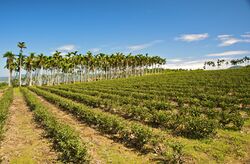
Agriculture has served as a strong foundation for Taiwan's economic miracle.[116] It contributes 3% to GDP and the service sector makes up 73% of the economy. After retrocession from Japan in 1945, the government announced a long-term strategy of "developing industry through agriculture, and developing agriculture through industry".[117] As such, agriculture became the foundation for Taiwan's economic development during early years and served as an anchor for growth in industry and commerce. Where as in 1951 agricultural production accounted for 35.8% of Taiwan's GDP,[117] by 2013 it had been vastly surpassed and its NT$475.90 billion accounted for only 1.69% of the GDP. اعتبارا من 2013[تحديث], Taiwan's agriculture was a mixture of crops (47.88%), livestock (31.16%), fishery (20.87%) and forestry (0.09%).[118] Since its accession into the World Trade Organization and the subsequent trade liberalization, the government has implemented new policies to develop the sector into a more competitive and modernized green industry.[119]
Although only about one-quarter of Taiwan's land area is suitable for farming, virtually all farmland is intensely cultivated, with some areas suitable for two and even three crops a year. However, increases in agricultural production have been much slower than industrial growth. Agricultural modernization has been inhibited by the small size of farms and the lack of investment in better facilities and training to develop more profitable businesses.[119] Taiwan's agricultural population has steadily decreased from 1974 to 2002, prompting the Council of Agriculture to introduce modern farm management, provide technical training, and offer counseling for better production and distribution systems.[119] Promotion of farm mechanization has helped to alleviate labor shortages while increasing productivity; both rice and sugar cane production are completely mechanized.[120] Taiwan's main crops are rice, sugar cane, fruits (many of them tropical), and vegetables. Although self-sufficient in rice production, Taiwan imports large amounts of wheat, mostly from the United States. Meat production and consumption has risen sharply, reflecting a high standard of living. Taiwan has exported large amounts of frozen pork, although this was affected by an outbreak of hoof and mouth disease in 1997. Other agricultural exports include fish, aquaculture and sea products, canned and frozen vegetables, and grain products. Imports of agriculture products are expected to increase due to the WTO accession, which is opening previously protected agricultural markets.[بحاجة لمصدر]
الطاقة
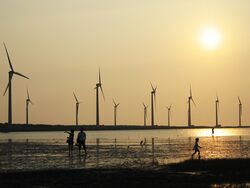
Due to the lack of natural resources on the island, Taiwan is forced to import many of its energy needs (currently at 98%).[121] Imported energy totaled US$11.52 billion in 2002, accounting for 4.1% of its GDP.[122] Although the industrial sector has traditionally been Taiwan's largest energy consumer, its share has dropped in recent years from 62% in 1986 to 58% in 2002.[122] Taiwan's energy consumption is dominated by crude oil & petroleum products (48.52%), followed by coal (29.2%), natural gas (12.23%), nuclear power (8.33%), and hydroelectric power (0.28%).[123] The island is also heavily dependent on imported oil, with 72% of its crude oil coming from the Middle East in 2002. Although the Taiwan Power Company (Taipower), state-owned enterprise, is in charge of providing electricity for the Taiwan area, a 1994 measure has allowed independent power producers (IPPs) to provide up to 20% of the island's energy needs.[124] Indonesia and Malaysia supply most of Taiwan's natural gas needs.[124] It currently has three operational nuclear power plants. A fourth plant under construction was mothballed in 2014.[125]
Although Taiwan's per capita energy use is on par with neighboring Asian countries,[126] in July 2005 the Ministry of Economic Affairs announced plans to cut 170 million-tons of carbon dioxide emissions by 2025.[124] In 2010, carbon dioxide emissions have been reduced by 5.14 million metric tons.[127] In order to further reduce emissions, the government also plans to increase energy efficiency by 2% each year through 2020.[128] In addition, by 2015 emissions are planned to be reduced by 7% compared to 2005 levels.[128]
Taiwan is the world's 4th largest producer of solar-powered batteries and largest LED manufacturer by volume.[127] In 2010, Taiwan had over 1.66 million square meters of solar heat collectors installed, with an installation density that ranks it as third in the world.[129] The government has already built 155 sets of wind turbines capable of producing 281.6 MW of energy, and additional projects are planned or under construction.[130] Renewable energy accounts for 6.8% of Taiwan's energy usage as of 2010.[128] In 2010, the green energy sector generated US$10.97 billion in production value.[127] The government also announced plans to invest US$838 million for renewable energy promotion and an additional US$635 million for research and development.[128]
الصلب والصناعات الثقيلة
Taiwan, as of 2017, is the world's thirteenth-largest steel exporter. In 2018, Taiwan exported 12.2 million metric tons of steel, a one percent increase from 12.0 million metric tons in 2017. Taiwan's exports represented about 3 percent of all steel exported globally in 2017, based on available data. The volume of Taiwan's 2018 steel exports was one-sixth that of the world's largest exporter, China, and nearly one-third that of the second-largest exporter, Japan. In value terms, steel represented just 3.6 percent of the total amount of goods Taiwan exported in 2018. Taiwan exports steel to more than 130 countries and territories. Over the decade from 2009 to 2019, Taiwan grew its steel exports by 24%. In 2018, the US imported 300,000 metric tons of pipe and tube product. Taiwan has developed a vast export trade to its most proximate neighbours in flat products. Taiwan's stainless steel exports numbered in 2018 about 500,000 metric tons.[131]
Taiwan is the fourth largest exporter of machine tools and machine tool components in the world. The greater Taichung area is home to a cluster of machine tool manufacturers.[132]
Taiwanese company Techman Robot Inc. is the world's second largest producer of cobots.[133]
The automotive industry in Taiwan is significant with Taiwanese firms increasingly invested in automotive electrification, 75% of Tesla, Inc.’s suppliers are Taiwanese.[134]
الصناعات البحرية
In 2017 Taiwan exported one hundred and sixty two yachts.[135] In 2018 Taiwan was the fourth largest yacht building nation by feet of yacht built after Italy, The Netherlands and Turkey.[136] Taiwan is one of the largest fishing nations on earth and the associated fish processing industry is also significant.[137]
أكبر الشركات
According to the 2019 Forbes Global 2000 index, Taiwan's largest publicly traded companies are:
| Rank | Company | Revenues ($ billion) |
Profit ($ billion) |
Assets ($ billion) |
Market value ($ billion) |
|---|---|---|---|---|---|
| 1 | Hon Hai Precision | 175.6 | 4.3 | 110 | 41.2 |
| 2 | TSMC | 34.2 | 11.6 | 68 | 222.4 |
| 3 | Cathay Financial | 3.5 | 0.1 | 73.0 | 4.1 |
| 4 | Fubon Financial | 21.9 | 1.6 | 250.6 | 14.9 |
| 5 | CTBC Financial | 16.7 | 1.2 | 187.2 | 12.8 |
| 6 | Formosa Petrochemical | 25.5 | 2 | 13.2 | 35.4 |
| 7 | Formosa Chemicals | 13.5 | 1.6 | 19.2 | 20.6 |
| 8 | Nan Ya Plastics | 11 | 1.7 | 18.6 | 19.9 |
| 9 | Formosa Plastics | 7.6 | 1.6 | 13.2 | 35.4 |
| 10 | Formosa Petrochemical | 25.5 | 2 | 16.3 | 22.3 |
| 11 | China Steel | 13.3 | 0.8 | 21.9 | 12.6 |
| 12 | Chunghwa Telecom | 7.1 | 1.2 | 15.2 | 27.7 |
| 13 | Mega Financial Holding | 3.2 | 0.9 | 115.2 | 12.4 |
| 14 | ASE Group | 12.3 | 0.8 | 17.4 | 10.2 |
| 15 | Quanta Computer | 34.1 | 0.5 | 21.5 | 7.6 |
| 16 | Uni-President | 14.3 | 0.6 | 13.2 | 13.1 |
مجمعات العلوم والتكنولوجيا
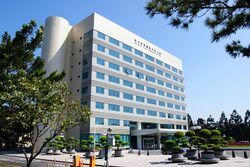
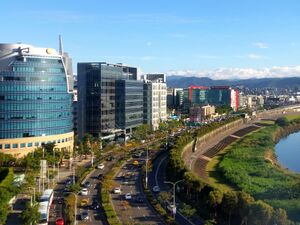
In order to promote industrial research and development, the government began establishing science parks, economic zones which provide rent and utility breaks, tax incentives and specialized lending rates to attract investment.[139] The first of these, the Hsinchu Science Park was established in 1980 by the National Science Council[140] with a focus on research and development in information technology and biotechnology.[139][141] It has been called Taiwan's "Silicon Valley"[142][143] and has expanded to six campuses covering an area of 1,140 hectares (11.4 km2).[144] Over 430 companies (including many listed on TAIEX) employing over 130,000 people are located within the park, and paid in capital totaled US$36.10 billion in 2008.[145] Both Taiwan Semiconductor Manufacturing Company and United Microelectronics Corporation, the world's largest and second largest contract chipmakers,[101] are headquartered within the park. Since 1980, the government has invested over US$1 billion in the park's infrastructure,[141] and further expansion for more specialized parks have been pursued.[145] The Industrial Technology Research Institute (ITRI), headquartered within the park, is the largest nonprofit research organization in Taiwan and has worked to develop applied technological research for industry, including for many of Taiwan's traditional industries (such as textiles).[141]
Following the success of the first park, the Southern Taiwan Science Park (STSP), consisting of the Tainan Science Park and the Kaohsiung Science Park, was established in 1996.[139] In addition to companies, several research institutes (including Academia Sinica) and universities have set up branches within the park with a focus on integrated circuits (ICs), optoelectronics, and biotechnology.[145] The Central Taiwan Science Park (CTSP) was established more recently in 2003.[146] While the CTSP is still under development, many firms (including AU Optronics) have already moved into the park and begun manufacturing operations.[146] Like the other parks, CTSP also focuses on ICs, optoelectronics, and biotechnology, with the optoelectronics industry accounting for 78% of its revenue in 2008.[145] These three science parks alone have attracted over NT$4 trillion (US$137 billion) worth of capital inflow,[141] and in 2010 total revenue within the parks reached NT$2.16 trillion (US$72.8 billion).[147]
The Linhai Industrial Park, established in Kaohsiung in 1960,[148] is a well-developed industrial zone with over 490 companies focusing on other industries including base metals, machinery and repairs, nonmetallic mineral products, chemical products, and food and beverage manufacturing.[149] The Changhua Coastal Industrial Park, located in Changhua County, is a newer industrial cluster with many different industries such as food production, glass, textiles, and plastics.[150]
The complete lists of industrial and science parks in Taiwan are:
- Central Taiwan Science Park
- Hsinchu Science Park
- Kaohsiung Science Park
- Nankang Software Park
- Neihu Science Park
- Tainan Science Park
معاهد الأبحاث الاقتصادية
- Taiwan Institute of Economic Research
- Chung-Hua Institution for Economic Research
- Institute of Economics, Academia Sinica
- Industrial Technology Research Institute
- Taiwan Livestock Research Institute
انظر أيضاً
- المصارف في تايوان
- صناعة الاسمنت في تايوان
- صناعة الدفاع في تايوان
- قائمة البنوك في تايوان
- List of Taiwanese automakers
- قائمة شركات تايوان
- قائمة أكبر الشركات في تايوان
- List of metropolitan areas in Taiwan
- صنع في تايوان
- معجزة تايوان
- Taiwanese Wave
- Minimum wage in Taiwan
- الضرائب في تايوان
- النقل في تايوان
- بورصة تايوان (TSE)
- صناعة النسيج في تايوان
ملاحظات
- ^ data for central government
المراجع
- ^ "Latest indicators". eng.stat.gov.tw. National Statistics, Republic of China (Taiwan). Archived from the original on 31 January 2020. Retrieved 22 Feb 2021.
- ^ أ ب c=171,193,122,124,156,423,935 ,128,939,172,132,134,174,532,176,178,436,136, 158,542,941,946,137,546,181,138,196,142, 182,359,135,576,936,961,184,144,146,528,112,111,&s=NGDPD,&sy=2020&ey=2026&ssm=0&scsm=1&scc=0&ssd=1&ssc=0&sic=0&sort=country&ds=.&br=1 "World Economic Outlook Database, October 2021". IMF.org. International Monetary Fund. Archived from the original on 13 October 2021. Retrieved 14 October 2021.
{{cite web}}:|archive-date=/|archive-url=timestamp mismatch; 25 سبتمبر 2020 suggested (help); Check|url=value (help) - ^ "World Economic Outlook Database, April 2020". IMF.org. International Monetary Fund. Retrieved 21 April 2020.
- ^ أ ب ت ث ج "GDP: Preliminary Estimate for 2021Q3 and Outlook for 2021". dgbas.gov.tw. Directorate-General of Budget Accounting and Statistics Executive Yuan. Retrieved 22 Feb 2021.
- ^ أ ب ت ث ج ح خ د ذ ر ز "The World Factbook". CIA.gov. Central Intelligence Agency. Retrieved 12 May 2019.
- ^ "Ease of Doing Business in Taiwan, China". Doingbusiness.org. Archived from the original on 19 December 2016. Retrieved 23 January 2017.
- ^ أ ب "Import and Export:Preliminary Estimate for 2020". mof.gov.tw. Ministry of Finance,R.O.C. Retrieved 22 Feb 2021.
- ^ أ ب "Trade Profile - Chinese Taipei". World Trade Organization. 2016. Archived from the original on 23 August 2018. Retrieved 8 October 2018.
- ^ "Taiwan Ratings Raised To 'AA/A-1+' With Positive Outlook". S&P Global. Retrieved 2021-08-11.
- ^ Rogers, Simon; Sedghi, Ami (15 April 2011). "How Fitch, Moody's and S&P rate each country's credit rating". The Guardian. Archived from the original on 1 August 2013. Retrieved 28 May 2011.
- ^ "Moody's - credit ratings, research, tools and analysis for the global capital markets". Moody's. 2021-02-24. Retrieved 2021-08-11.
- ^ "Taiwan - Credit Rating". fitchratings.com. Retrieved 11 September 2021.
- ^ "Taiwan Credit Rating".
- ^ "Latest Indicator 2021". dgbas.gov.tw. Directorate-General of Budget Accounting and Statistics Executive Yuan. Retrieved 22 Feb 2021.
- ^ "Select Aggregates". Imf.org. Archived from the original on 14 March 2019. Retrieved 27 July 2018.
- ^ "World Bank Country and Lending Groups – World Bank Data Help Desk". datahelpdesk.worldbank.org. Archived from the original on 11 January 2018. Retrieved 27 July 2018.
- ^ "Archived copy". The Economist. Archived from the original on 1 March 2019. Retrieved 27 August 2019.
{{cite news}}: CS1 maint: archived copy as title (link) - ^ "Archived copy". Bloomberg News. Archived from the original on 9 August 2019. Retrieved 27 August 2019.
{{cite web}}: CS1 maint: archived copy as title (link) - ^ "Archived copy". Archived from the original on 12 May 2019. Retrieved 27 August 2019.
{{cite web}}: CS1 maint: archived copy as title (link) - ^ "Taiwanese navy fires NUCLEAR MISSILE at fisherman during horrifying accident". Daily Mirror. 29 August 2016. Archived from the original on 3 April 2019. Retrieved 27 August 2019.
- ^ Taiwan Investment in China Archived 21 أبريل 2011 at the Wayback Machine
- ^ Dunbabin, J. P. D. (2008). The Cold War. Pearson Education. p. 187. ISBN 978-0-582-42398-5. Archived from the original on 10 June 2016. Retrieved 12 November 2015.
In 1949 Chiang Kai-shek had transferred to Taiwan the government, gold reserve, and some of the army of his Republic of China.
- ^ Ng, Franklin (1998). The Taiwanese Americans. Greenwood Publishing Group. p. 10. ISBN 9780313297625. Archived from the original on 2 January 2016. Retrieved 12 November 2015.
- ^ "Taiwan Timeline - Retreat to Taiwan". BBC News. 2000. Archived from the original on 24 June 2009. Retrieved 21 June 2009.
- ^ أ ب ت ث ج "The Story of Taiwan - Economy". Taiwan.com.au. Archived from the original on 2 فبراير 2010. Retrieved 23 ديسمبر 2010.
- ^ "Taipei Taitra - List of TAITRA overseas offices". Taipei.taiwantrade.com.tw. Archived from the original on 28 October 2016. Retrieved 9 November 2013.
- ^ "Archived copy" (PDF). Archived from the original (PDF) on 9 يوليو 2014. Retrieved 18 فبراير 2013.
{{cite web}}: CS1 maint: archived copy as title (link) - ^ "The Definition, Purposes, Functions and Services of Incubation Centers". Incubator.moeasmea.gov.tw. Archived from the original on 7 October 2019. Retrieved 27 July 2018.
- ^ https://www.imf.org/en/Publications/WEO/weo-database/2021/October/weo-report?c=528,&s=NGDP_RPCH,NGDPD,PPPGDP,NGDPDPC,PPPPC,PCPIPCH,LUR,GGXWDG_NGDP,&sy=1980&ey=2026&ssm=0&scsm=1&scc=0&ssd=1&ssc=0&sic=0&sort=country&ds=.&br=1
- ^ "最新統計指標". 主計處. 行政院主計處. Archived from the original on 24 June 2020. Retrieved 2 May 2020.
- ^ "表格: 國民所得統計常用資料(2008SNA)-年". IIS Windows Server (in الصينية). Archived from the original on 30 July 2020. Retrieved 2020-01-06.
- ^ According to [1] Archived 9 نوفمبر 2017 at the Wayback Machine (IMF-WEO April 2017), PPP rate is NTD 15.11 per Int'l.dollar; according to the [2] Archived 23 نوفمبر 2017 at the Wayback Machine, the average exchange rate is NTD 32.258135 per US dollar (the average exchange rate of the year was 32.258135 NTD to 1 USD); GDP per capita figures in USD are retrieved from [3] Archived 21 فبراير 2018 at the Wayback Machine and are published by National Statistics of Republic of China (Taiwan)[4] Archived 30 أكتوبر 2017 at the Wayback Machine.
- ^ "薪資行情大調查 電信業月薪破10萬最高". Chinatimes.com. Archived from the original on 22 June 2018. Retrieved 27 July 2018.
- ^ "The China Post". The China Post. Archived from the original on 23 July 2017. Retrieved 27 July 2018.
- ^ "Documents" (PDF). isites.harvard.edu. Archived (PDF) from the original on 3 July 2013. Retrieved 12 October 2012.
- ^ "National Statistics, Republic of China (Taiwan)". eng.stat.gov.tw. Archived from the original on 25 April 2009. Retrieved 27 July 2018.
- ^ "Ministry of Economic Affairs, R.O.C. - Statistics of Economic". Moea.gov.tw. 14 نوفمبر 2013. Archived from the original on 15 يوليو 2013.
- ^ أ ب ت ث ج "Taiwan - Economy". QFinance. Archived from the original on 29 أغسطس 2010. Retrieved 23 ديسمبر 2010.
- ^ أ ب ت Skarica, David (2010). The Great Super Cycle: Profit from the Coming Inflation Tidal Wave and Dollar Devaluation. John Wiley and Sons. p. 208. ISBN 978-0-470-62418-0. Archived from the original on 25 September 2020. Retrieved 22 February 2019.
- ^ "Downloads - 2013 - White Paper - AmCham - American Chamber of Commerce in Taipei - 臺北市美國商會". Amcham.com.tw. Archived from the original on 16 March 2015. Retrieved 4 March 2015.
- ^ "Market Insights - Michael Page" (PDF). Michael Page. Retrieved 27 July 2018.
- ^ "Asia Pacific Indirect Tax Country Guide" (PDF). Kpmg.de. Archived from the original (PDF) on 4 April 2013. Retrieved 6 August 2018.
- ^ "Mastercard : 2014 Global Destination Cities Index" (PDF). Newsroom.mastercard.com. Archived (PDF) from the original on 16 September 2018. Retrieved 6 August 2018.
- ^ "Jobless rate falls to 2-year low in November". China Post. 22 December 2010. Archived from the original on 26 December 2010. Retrieved 22 December 2010.
- ^ "Taiwan's jobless rate drops to 40-month low in December". Focus Taiwan News Channel. 30 January 2011. Archived from the original on 4 August 2020. Retrieved 30 January 2011.
- ^ "Regular salary up for 12 consecutive months". Focus Taiwan News Channel. 22 December 2010. Archived from the original on 18 January 2012. Retrieved 22 December 2010.
- ^ "November industrial production index hits fresh high". Focus Taiwan News Channel. 23 December 2010. Archived from the original on 19 January 2012. Retrieved 23 December 2010.
- ^ "Taiwan retail sales forecast to hit record high this year". Focus Taiwan News Channel. 24 December 2010. Archived from the original on 18 January 2012. Retrieved 25 December 2010.
- ^ Judy Li (19 يناير 2011). "Taiwan's Economic Growth to Reach 5% in 2011: the World Bank". China Economic News Service. Archived from the original on 24 يناير 2011. Retrieved 19 يناير 2011.
- ^ "Taiwan economy remains sluggish in May amid global trade war". Archived from the original on 29 June 2019. Retrieved 29 June 2019.
- ^ Ralph Jennings (10 January 2011). "Tablets, Internet-linked Smart Sensors to Star at Computex". PC World. Retrieved 19 January 2011.
- ^ "Computex show draws over 23,300 foreign buyers". ZDNet. 11 June 2001. Archived from the original on 18 April 2012. Retrieved 19 January 2011.
- ^ "Services of Economic Division". Taipei Economic and Cultural Office, Canada. Archived from the original on 3 أكتوبر 2011. Retrieved 23 ديسمبر 2010.
- ^ أ ب ت "Import by Key Trading Partners". Ministry of Economic Affairs. ديسمبر 2010. Archived from the original on 5 أكتوبر 2013. Retrieved 23 ديسمبر 2010.
- ^ أ ب ت "Export by Key Trading Partners". Ministry of Economic Affairs. ديسمبر 2010. Archived from the original on 5 أكتوبر 2013. Retrieved 23 ديسمبر 2010.
- ^ "East Asia/Southeast Asia :: Taiwan - The World Factbook". Central Intelligence Agency. 2020-02-07. Retrieved 2020-02-29.
Taiwan's diplomatic isolation, low birth rate, rapidly aging population, and increasing competition from China and other Asia Pacific markets are other major long-term challenges.Taiwan's total fertility rate of just over one child per woman is among the lowest in the world, raising the prospect of future labor shortages, falling domestic demand, and declining tax revenues. Moreover, Taiwan's population is aging quickly, with the number of people over 65 expected to account for nearly 20% of the island's total population by 2025.President TSAI's administration has made little progress on the domestic economic issues that loomed large when she was elected, including concerns about stagnant wages, high housing prices, youth unemployment, job security, and financial security in retirement.
- ^ "Asian Development Outlook (ADO) 2020: What Drives Innovation in Asia?" (PDF). Asian Development Bank. 2020-04-03. pp. 207–208. ISSN 1996-725X. Archived from the original on 2020-04-07. Retrieved 2020-04-07.
- ^ "Background paper" (PDF). Un.org. Archived (PDF) from the original on 12 July 2017. Retrieved 28 June 2017.
- ^ "Data" (PDF). unctad.org. Archived (PDF) from the original on 29 August 2017. Retrieved 27 February 2018.
- ^ Karimaa, Alexandra (February 2013). "Value-Aware Approach to Management of Innovative Software Products and Services" (PDF). www.joebm.com. Archived (PDF) from the original on 27 September 2015. Retrieved 27 September 2015.
- ^ "Archived copy" (PDF). iic.wiki.fgv.br. Archived from the original (PDF) on 13 August 2012. Retrieved 17 January 2022.
{{cite web}}: CS1 maint: archived copy as title (link) - ^ "Bloomberg Pursuits - Bloomberg". Bloomberg.com. Archived from the original on 1 July 2016. Retrieved 27 July 2018.
- ^ "Chinese Taipei". Innovationpolicyplatform.org. Archived from the original on 14 July 2018. Retrieved 27 July 2018.
- ^ "Taiwan world's third-best for investment: research firm". Focus Taiwan News Channel. 1 September 2011. Archived from the original on 19 January 2012. Retrieved 1 September 2011.
- ^ "Taiwan's ICT industry gears up for prosperous 2011". Taiwan Today. 23 ديسمبر 2010. Archived from the original on 18 يوليو 2011. Retrieved 23 ديسمبر 2010.
- ^ أ ب ت ث ج ح خ د "Major Industries in Taiwan". Taiwan.com.au. Archived from the original on 22 فبراير 2010. Retrieved 23 ديسمبر 2010.
- ^ "Research from TASC". Aseancenter.org.tw. Archived from the original on 3 July 2013. Retrieved 7 October 2012.
- ^ https://www.iea.org/countries/chinese-taipei
- ^ "Chinese Taipei - Organisation for Economic Co-operation and Development". Oecd.org. OECD Trade and Environment Working Papers. 2011. doi:10.1787/5kgcf71l188x-en. Archived from the original on 3 July 2013. Retrieved 13 October 2012.
- ^ "Chinese Taipei Business Council of ICC details | ICC - International Chamber of Commerce". Iccwbo.org. Archived from the original on 3 July 2013. Retrieved 13 October 2012.
- ^ Jenny W. Hsu And Aries Poon (7 November 2013). "Taiwan, Singapore Sign Free-Trade Pact". WSJ. Archived from the original on 2 April 2015. Retrieved 4 March 2015.
- ^ Lucy Craymer and Fanny Liu (11 July 2013). "Taiwan and New Zealand Sign Free-Trade Agreement". WSJ. Archived from the original on 31 March 2015. Retrieved 4 March 2015.
- ^ "Hong Kong, Taiwan seek to join AIIB". Chinadaily.com.cn. Archived from the original on 27 July 2018. Retrieved 27 July 2018.
- ^ "Chinese, Taiwan sign landmark economic pact". Xinhua News Agency. 24 يونيو 2010. Archived from the original on 3 يوليو 2010. Retrieved 29 يونيو 2010.
- ^ Taiwan News, ECFA signing scheduled for June 29 Archived 21 أكتوبر 2013 at the Wayback Machine 25 June 2010
- ^ John Pike (16 July 2009). "Taiwan Sees Gains in Closer Ties With China". Globalsecurity.org. Archived from the original on 5 September 2009. Retrieved 17 July 2009.
- ^ "Taiwan ranks fifth in major importers to China in 2010". China Post. CNA. 2 January 2011. Archived from the original on 25 September 2012. Retrieved 1 January 2010.
- ^ "Taiwan, Singapore prepare to forge economic partnership (update)". Focus Taiwan News Channel. 15 December 2010. Archived from the original on 19 January 2012. Retrieved 23 December 2010.
- ^ "Taiwan-US TIFA talks to resume next month". China Post. 23 December 2010. Archived from the original on 9 January 2011. Retrieved 23 December 2010.
- ^ San, Gee (1 April 1992). "Taiwanese Corporations in Globalisation and Regionalisation". OECD Development Centre Working Papers. doi:10.1787/263030024237. Archived from the original on 23 September 2018. Retrieved 27 July 2018.
- ^ "Are Three-letter Acronyms Holding Taiwan Hostage?". Ddg.com.tw. Archived from the original on 3 May 2019. Retrieved 27 July 2018.
- ^ "The Transformation of Taiwan's Status Within the Production and Supply Chain in Asia". Brookings.edu. Archived from the original on 12 June 2018. Retrieved 27 July 2018.
- ^ "III - Institute for Information Industry". Web.iii.org.tw. Archived from the original on 3 July 2013. Retrieved 26 January 2013.
- ^ "FIND-Foreseeing Innovative New Digiservices". Find.org.tw. Archived from the original on 8 أكتوبر 2010.
- ^ "Measuring the Information Society 2011" (PDF). Itu.int. Archived (PDF) from the original on 15 March 2016. Retrieved 6 August 2018.
- ^ "Industrial Technology Research Institute". Itri.org.tw. 1 April 2013. Archived from the original on 3 July 2013. Retrieved 26 January 2013.
- ^ Chow, Vivienne. "Taipei's Thriving Art Scene Looks to Become an International Star". www.artnews.com. Art News. Retrieved 14 July 2021.
- ^ أ ب ت ث "ICT to Taiwan". Australian Government. 18 November 2010. Archived from the original on 10 January 2011. Retrieved 23 December 2010.
- ^ أ ب "e-Taiwan Program 2004". eTaiwan Program. 5 May 2005. Archived from the original on 21 July 2011. Retrieved 23 December 2010.
- ^ "Taiwan's Optoelectronics industry totals NT$2.2 tril". China Post. 6 January 2011. Archived from the original on 9 January 2011. Retrieved 5 January 2011.
- ^ "Electronics industry stats" (PDF). unstats.un.org. 2010. Archived (PDF) from the original on 3 May 2019. Retrieved 3 November 2012.
- ^ "Data" (PDF). file.icsead.or.jp. Archived (PDF) from the original on 3 July 2013. Retrieved 27 October 2012.
- ^ "Slush CSO on Taiwan's Startups: Youth Must Take the Lead". Beyond Times. 13 November 2015. Archived from the original on 26 August 2016. Retrieved 15 August 2016.
- ^ Leichman, Abigail Klein (July 2016). "Taiwan Students Fly To Israel for a Taste of Startup Sauce". Israel 21C. Archived from the original on 21 July 2016. Retrieved 15 August 2016.
- ^ Liao, George. "Taiwan's sporting goods production expected to break NT$60 billion this year". www.taiwannews.com.tw. Taiwan News. Retrieved 5 August 2021.
- ^ Wu, Ching Fang. "Taiwan's Golf Gear Manufacturers Bounce Back as Tiger Woods Returns to Glory". english.cw.com.tw. Commonwealth Magazine. Retrieved 5 August 2021.
- ^ Liu, Philip. "Swinging For the Fairway: Taiwan Golf Equipment". topics.amcham.com.tw. Taiwan Topics. Retrieved 5 August 2021.
- ^ أ ب ت "Emerging Industries". Taiwan.com.au. Archived from the original on 15 سبتمبر 2009. Retrieved 19 يناير 2011.
- ^ "The Status of the Semiconductor Industry in Taiwan" (PDF). Department of Investment Services, MOEA. Archived from the original (PDF) on 27 August 2011. Retrieved 19 January 2011.
- ^ أ ب ت Meg Chang (18 يونيو 2010). "Veteran tells story of Taiwan's semiconductor industry". Taiwan Today. Archived from the original on 30 أغسطس 2011. Retrieved 19 يناير 2011.
- ^ أ ب "UPDATE 1-UMC posts weaker sales; fresh demand seen". Reuters. 7 January 2011. Archived from the original on 11 January 2011. Retrieved 17 January 2011.
- ^ "13 Fabless IC Suppliers Forecast to Top $1.0 Billion in Sales in 2010!". IC Insights. 21 December 2010. Archived from the original on 26 December 2010. Retrieved 19 January 2011.
- ^ Jeffrey Word (2009). Business Network Transformation: Strategies to Reconfigure Your Business Relationships for Competitive Advantage. John Wiley and Sons. p. 194. ISBN 9780470528341.
- ^ John A. Matthews (1997). "A Silicon Valley of the East: Creating Taiwan's Semiconductor Industry" (PDF). California Management Reviews. p. 26. Archived from the original (PDF) on 17 يوليو 2011. Retrieved 19 يناير 2011.
- ^ "Taiwan semiconductor output overtakes United States". China Post. 29 October 2007. Archived from the original on 20 May 2011. Retrieved 18 January 2011.
- ^ "Taiwan's Semiconductor Industry Records Fastest YOY Growth". RNCOS. 6 January 2010. Archived from the original on 25 May 2010. Retrieved 19 January 2011.
- ^ "Taiwan's TSMC sales rise more than 40% in 2010". Agence France-Presse. 10 January 2011. Archived from the original on 26 February 2014. Retrieved 19 January 2011.
- ^ "UMC posts record annual sales as foundry picks up". Taipei Times. 8 January 2011. p. 12. Archived from the original on 8 October 2012. Retrieved 19 January 2011.
- ^ Agam Shah (8 May 2013). "Intel: We don't see the end of Moore's Law yet". CITEworld. Archived from the original on 1 March 2014. Retrieved 4 March 2015.
- ^ "Science and technology: No Moore? - The Economist". The Economist. Archived from the original on 27 February 2015. Retrieved 4 March 2015.
- ^ Chien-chung, Chang; Huang, Frances. "Taiwan to remain largest semiconductor material market in 2020, 2021". focustaiwan.tw. Focus Taiwan. Retrieved 17 November 2020.
- ^ Chang, Chun-Yen (2001). Made by Taiwan: booming in the information technology era. World Scientific. p. vii. ISBN 9789810247799.
- ^ Chang, Chun-Yen (2001). Made by Taiwan: booming in the information technology era. World Scientific. p. x. ISBN 9789810247799. Archived from the original on 2 May 2016. Retrieved 12 November 2015.
- ^ "Schedules of concessions". World Trade Organization. Archived from the original on 3 February 2018. Retrieved 23 December 2010.
- ^ Chan, KG. "Taiwan lures businesses amid Hong Kong jitters". asiatimes.com. Asia Times. Archived from the original on 21 June 2020. Retrieved 19 June 2020.
- ^ "Land and Natural Environment". Council of Agriculture, Executive Yuan. Archived from the original on 28 July 2011. Retrieved 23 December 2010.
- ^ أ ب "The Story of Taiwan: Preface". Government Information Office, ROC. Archived from the original on 14 نوفمبر 2011. Retrieved 23 ديسمبر 2010.
- ^ "Archived copy". Archived from the original on 24 سبتمبر 2015. Retrieved 11 يوليو 2015.
{{cite web}}: CS1 maint: archived copy as title (link) - ^ أ ب ت "Agriculture". Taiwan.com.au. Archived from the original on 15 سبتمبر 2009. Retrieved 23 ديسمبر 2010.
- ^ "Mechanization". Council of Agriculture, Executive Yuan. Archived from the original on 28 July 2011. Retrieved 23 December 2010.
- ^ "Sustainable Development of Renewable Energy". Ministry of Economic Affairs, Bureau of Energy. Archived from the original on 8 أكتوبر 2011. Retrieved 25 ديسمبر 2010.
- ^ أ ب "Energy". Taiwan.com.au. Archived from the original on 15 سبتمبر 2009. Retrieved 25 ديسمبر 2010.
- ^ "Energy Supply". Ministry of Economic Affairs, Bureau of Energy. Archived from the original on 4 March 2016. Retrieved 24 November 2015.
- ^ أ ب ت "Taiwan". Energy Information Administration, Department of Energy, USA. Archived from the original on 15 ديسمبر 2006. Retrieved 25 ديسمبر 2010.
- ^ Lin, Sean (4 February 2015). "AEC approves plan to shutter fourth nuclear facility". Taipei Times. Archived from the original on 9 February 2015. Retrieved 5 March 2015.
- ^ "Per Capita GDP and Primary Energy Consumption in Major Countries (2007)" (PDF). Ministry of Economic Affairs, Bureau of Energy. Archived from the original (PDF) on 18 May 2011. Retrieved 25 December 2010.
- ^ أ ب ت "Taiwan's Green Energy Production Value Surges to NT$340B. in First 11 Months of 2010". CENS. 23 ديسمبر 2010. Archived from the original on 24 يوليو 2011. Retrieved 25 ديسمبر 2010.
- ^ أ ب ت ث Edward C. Gates (25 December 2010). "Investment Plan by Taiwan". Biofuels Watch. Archived from the original on 18 July 2011. Retrieved 25 December 2010.
- ^ "II. Solar Energy". Ministry of Economic Affairs, Bureau of Energy. Archived from the original on 8 أكتوبر 2011. Retrieved 25 ديسمبر 2010.
- ^ "I. Wind Energy". Ministry of Economic Affairs, Bureau of Energy. Archived from the original on 8 أكتوبر 2011. Retrieved 25 ديسمبر 2010.
- ^ "Global Steel Trade Monitor - Steel Exports Report: Taiwan" (PDF). US Department of Commerce. International Trade Administration. May 2019. Archived from the original (PDF) on 28 June 2017. Retrieved 9 October 2019.
- ^ "Taiwan: Supporting the Next Generation of Aerospace Manufacturing". www.mmsonline.com. Modern Machine Shop. Archived from the original on 11 July 2020. Retrieved 8 July 2020.
- ^ Huang, Elaine. "This Made-in-Taiwan Robot Is Drawing International Attention". english.cw.com.tw. CommonWealth. Archived from the original on 25 December 2019. Retrieved 8 July 2020.
- ^ Lu, Kuo-chen (20 October 2020). "Taiwan's Tesla Boom, and Looking for More". topics.amcham.com.tw. Topics. Retrieved 29 October 2020.
- ^ Murray, Simon. "Yacht Building in Taiwan". www.powerandmotoryacht.com. Power and Motoryacht. Archived from the original on 12 May 2019. Retrieved 5 December 2019.
- ^ "Global Order Book". www.boatinternational.com. Boat International. Archived from the original on 12 May 2019. Retrieved 5 December 2019.
- ^ Gulle, Warwick. "Fishing industry - Taiwan". ro.uow.edu.au. Berkshire Publishing Group. Archived from the original on 12 October 2015. Retrieved 5 December 2019.
- ^ "Forbes The World's Biggest Public Companies 2016 Ranking". Forbes. Archived from the original on 2 October 2019. Retrieved 3 May 2020.
- ^ أ ب ت "Science Parks in Taiwan". About.com. 25 September 2008. Archived from the original on 7 July 2011. Retrieved 17 January 2011.
- ^ "Taiwan's biotech-focused Science Parks". Biotech East. Archived from the original on 10 September 2011. Retrieved 17 January 2011.
- ^ أ ب ت ث "Public Sector Research Facilities". Taiwan.com.au. Archived from the original on 12 سبتمبر 2009. Retrieved 17 يناير 2011.
- ^ Sara Robinson (22 September 1999). "Taiwan's Chip Plants Left Idle by Earthquake". The New York Times. Archived from the original on 14 July 2012. Retrieved 17 January 2011.
- ^ Dan Nystedt (24 April 2008). "LSI's China Plan Changed by Taiwan Election". ABC News. Archived from the original on 26 December 2011. Retrieved 17 January 2011.
- ^ "An introduction to the Hsinchu Science Park". Hsinchu Science Park. Archived from the original on 27 September 2011. Retrieved 17 January 2011.
- ^ أ ب ت ث "Science Parks". Government Information Office, Executive Yuan. 25 مايو 2010. Archived from the original on 27 يوليو 2011. Retrieved 17 يناير 2011.
- ^ أ ب "Origins". Central Taiwan Science Park. Archived from the original on 22 April 2010. Retrieved 17 January 2011.
- ^ "Taiwan top-3 science parks to generate revenues of NT$2.45 trillion in 2011". DigiTimes. 24 February 2011. Archived from the original on 25 February 2011. Retrieved 23 February 2011.
- ^ "Kaohsiung LihHai Industrial Park". Kaohsiung LinHai Industrial Park Service Center. Archived from the original on 7 May 2011. Retrieved 17 January 2011.
- ^ "About Us". Kaohsiung LinHai Industrial Park Service Center. Archived from the original on 4 October 2011. Retrieved 17 January 2011.
- ^ "Environments of Changhua County". Invest in Taiwan, Department of Investment Services. Archived from the original on 25 September 2020. Retrieved 17 January 2011.
للاستزادة
| مراجع مكتبية عن اقتصاد تايوان |
- Taiwan ASEAN Studies Center; ASEAN Outlook Magazine; May 2013. Myanmar’s Overlooked Industry Opportunities and Investment Climate, by David DuByne
وصلات خارجية
- Official website (in صينية)
- Statistical Information Network of the Republic of China This website serves as a national statistical portal of the Republic of China.
- Taiwan Economic Journal
- Research Center for Taiwan Economic Development
- CS1 errors: archive-url
- CS1 errors: URL
- CS1 الصينية-language sources (zh)
- Short description is different from Wikidata
- Missing redirects
- Articles with hatnote templates targeting a nonexistent page
- كل المقالات بدون مراجع موثوقة
- كل المقالات بدون مراجع موثوقة from November 2021
- All articles with failed verification
- Articles with failed verification from November 2021
- جميع المقالات التي فيها عبارات متقادمة
- Articles with unsourced statements from July 2021
- Official website different in Wikidata and Wikipedia
- Articles with صينية-language sources (zh)
- APEC
- اقتصاد تايوان
- World Trade Organization member economies

